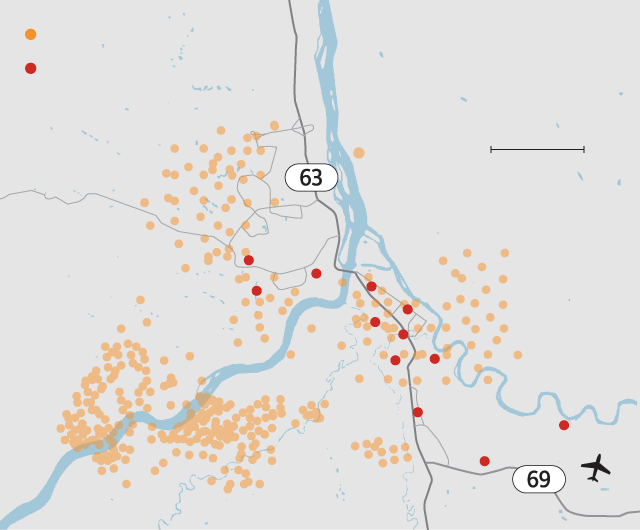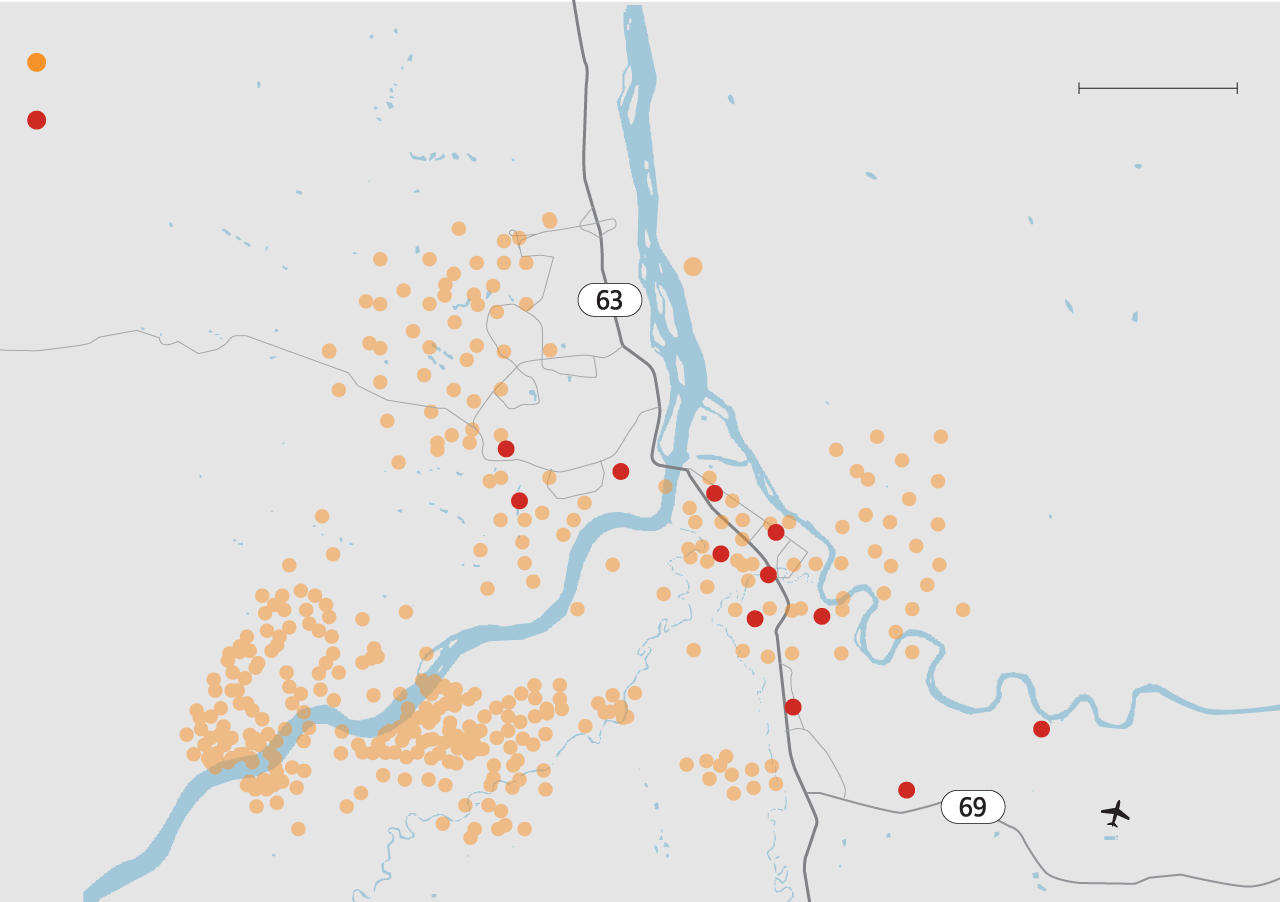A helicopter battles a wildfire in Fort McMurray, Alta., on Wednesday May 4, 2016. The wildfire has already torched 1,600 structures in the evacuated oil hub of Fort McMurray and is poised to renew its attack in another day of scorching heat and strong winds.Jason Franson
The Fort McMurray fire: How you can help, and receive help
As a massive wildfire continues to sweep through Fort McMurray and surrounding area, triggering the largest fire evacuation in Alberta's history, tens of thousands of people forced from their homes are left wondering if they will have anything to return to at all.
The Alberta government declared a state of emergency on Wednesday as two more communities prepared to evacuate. People fleeing the areas endured a slow but dramatic crawl along Highway 63 as huge plumes of ash darkened the sky.
Just after midnight ET (10 p.m. MT), residents who had fled Fort MacMurray to nearby Anzac, Alta., were told they would have to move again urgently.
The Rural Municipality of Wood Buffalo tweeted that because of changing weather patterns, the residents were advised by Alberta Forestry to clear out Anzac, Gregoire Estates and Fort McMurray First Nation.

Fire hotspots for the last 24 hours*
Neighbourhoods under mandatory evacuation
0
4
KM
Thickwood
Dickinsfield
Downtown
Wood Buffalo
Lower Townsite
Abasand
Grayling Terrace
Waterways
Beacon Hill
Gregoire
Draper
Saline Creek

0
4
Fire hotspots for the last 24 hours*
KM
Neighbourhoods under mandatory evacuation
Thickwood
Dickinsfield
Downtown
Wood Buffalo
Lower Townsite
Abasand
Grayling Terrace
Waterways
Beacon Hill
Gregoire
Draper
Saline Creek

0
4
Fire hotspots for the last 24 hours*
KM
Neighbourhoods under mandatory evacuation
Thickwood
Dickinsfield
Downtown
Wood Buffalo
Lower Townsite
Abasand
Grayling Terrace
Waterways
Beacon Hill
Gregoire
Draper
Saline Creek

0
4
Fire hotspots for the last 24 hours*
KM
Neighbourhoods under mandatory evacuation
Thickwood
Dickinsfield
Downtown
Wood Buffalo
Lower Townsite
Abasand
Grayling Terrace
Waterways
Beacon Hill
Gregoire
Draper
Saline Creek
Fort McMurray Intl Airport
"Buses are being assembled," said officials. "RCMP is going door-to-door."
The evacuation was scheduled to begin overnight and buses were to start ferrying people to Lac La Biche.
Officials stressed that residents were urged to remain calm "as there is adequate time for evacuation in a safe and timely manner."
Earlier, family, friends and strangers in the areas near Fort MacMurray offered their homes to evacuees, oil sands operations opened work force camps that had been largely shuttered due to the economic downturn, and trailer parks and camp grounds filled up. Accounts of terrifying journeys past blazing roadsides filled social media, and politicians from across the country – and even the Queen – sent wishes of support.
"This is a very explosive situation," warned Bernie Schmitte of Alberta's agriculture and forestry ministry. "These are catastrophic wildfires."
The fire, which was expected to reach 10,000 hectares by Wednesday night, has consumed about 1,600 buildings – the majority of homes in Beacon Hill and Waterways. High Level and Lac Ste. Anne County are now also under mandatory evacuation orders.
Scott Long, executive director of provincial operations for Alberta Emergency Management Agency, said the declaration of a state of emergency "essentially makes the situation ours," giving the province additional powers and full jurisdiction over the operation.
This includes "extraordinary measures" such as conscripting people to assist in firefighting, and bulldozing structures to create fire breaks if needed, Mr. Long said.
"I think, largely, the decision for a provincial state of emergency lends itself to the recovery and the response, which will take months to years, for sure."
Alberta Emergency Management Agency estimated that 80,000 people had fled Fort McMurray; the Regional Municipality of Wood Buffalo said the figure could be closer to 90,000. Of those forced to evacuate, approximately 10,000 are north of the city, where they have been directed to shelter at work camps.
"We have people that are scattered to trailer parks, campgrounds as well," Mr. Long said. "Obviously, many are staying with family and friends."
Insurance companies are readying for claims, comparing the devastation with one of the country's costliest natural disasters, the Slave Lake fire of 2011, which caused about $742-million in insured losses and destroyed about one-third of the town.
The disaster is a blow to a community already hit by plummeting oil prices; some of the area's biggest oil companies quickly scaled back production and most workers were sent home to deal with their personal situations.
No fatalities, serious injuries or missing persons have been reported related to the fire. However, two people were killed in a crash in the Lac la Biche area on Wednesday, when a tractor trailer hauling lumber hit an SUV on Highway 881. The fiery crash sparked a new blaze in trees and bushes nearby.
Those flames were considered under control by Wednesday evening, according to the RCMP. The cause of the crash is under investigation.
Chad Morrison, manager of wildfire prevention, said the larger fire "continues to expand outside on the borders and the edges of the fire at this time." Officials are still working to determine whether human activity or lightning caused the fire.
About 250 firefighters are on scene, along with 12 pieces of heavy equipment, said Danielle Larivee, Alberta's Minister of Municipal Affairs. As well, a dozen helicopters are engaged in suppression efforts.
Airspace is "completely saturated with as many aircraft as are safe," with the number adjusted hourly to meet conditions, Ms. Larivee said.
On Wednesday afternoon, after examining the damage in Fort McMurray, Alberta Premier Rachel Notley visited an evacuation centre in a recreation complex in Anzac, 40 kilometres to the south.
In Anzac, she met with officials, stopped briefly at the edge of the area where Fort McMurray residents were resting on cots and shook hands with a man waiting in the line for water and blankets.
Dozens of RCMP officials were in the evacuation centre, where officials organized buses and tried to make the displaced comfortable. Cots covered the hockey rink surface, the ring outside the boards and the area looking down on the playing surface. The centre also had food, water and a place for pets.
Ms. Notley reassured evacuated residents the province will support them.
"The government of Alberta is behind them," the Premier told reporters after touring the evacuation operation. "We may have a long road ahead of us, but they can count on not only the government, but the people of Alberta, to support them in the ways that we need.
"This is a devastating, devastating, event."
The "biggest victory" has been getting residents out of town safely, she said. "The most important thing that [citizens] can do is continue to follow instructions and not go back until it is safe."
Ottawa and Edmonton signed a memorandum of understanding Wednesday morning tied to support such as search and rescue. "In the recovery period … the federal government has a disaster recovery program and, of course, Albertans will need to access that."
The Premier said the firefighting operation has enough resources, such as trucks, trying to control the blaze. "Indeed, we've got a lot more that is on standby based on the needs," she said. "We've got everything that we need and more."
Brian Jean, the Leader of the Wildrose Party and a lifelong Fort McMurray resident, toured the city on Wednesday morning. His home in Waterways – along with belongings, ranging from his trucks, quads and jet boat – have been destroyed.
"I'm not worried about it because it is just stuff," the Leader of the Opposition said in an interview. "My family is safe and sound."
He added that people were still walking around town. "I've told them, 'Folks, you need to leave.' And they assured me that they are."
With reports from Jana G. Pruden in Edmonton
 Andrea Woo
Andrea Woo Carrie Tait
Carrie Tait